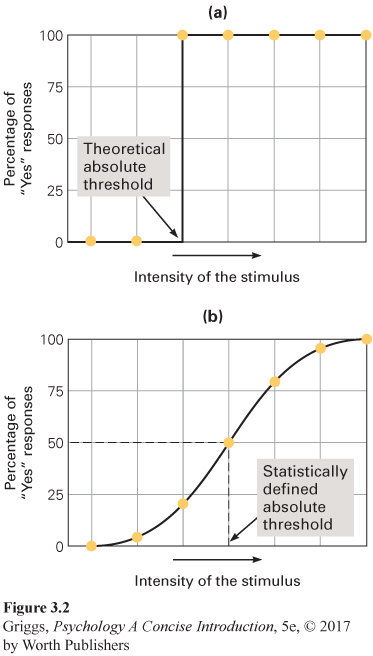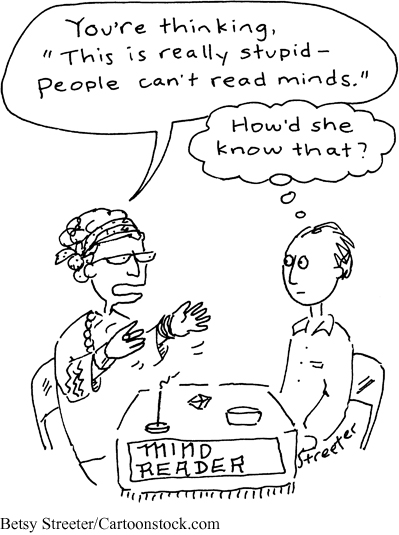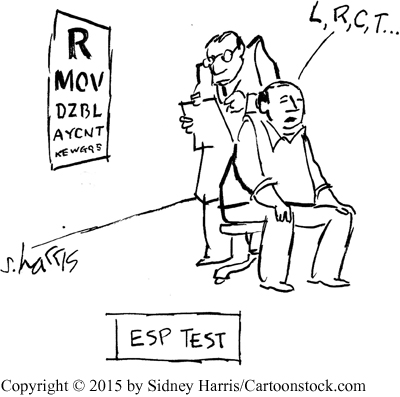3.1 How the Physical World Relates to the Psychological World
Just as the name implies, psychophysical research focuses on the relationship between the physical world and the psychological world. Early psychophysical researchers attempted to answer basic questions concerning how we process the intensities of physical energy forms such as light waves and sound waves. We will discuss three questions that they addressed in their research—
The detection and difference questions examine limits on our sensory processing. The detection question is concerned with the limits on our ability to detect very faint signals. How intense does a light have to be for us to see it? How intense does a sound have to be for us to hear it? Similarly, the difference question is concerned with limits on our detection abilities, but in this case with our ability to detect very small differences between stimuli. What is the smallest difference in brightness between two lights that we can see? What is the smallest difference in loudness between two sounds that we can hear? The scaling question is not concerned with sensory processing limits, but rather with how we perceive the magnitudes (intensities) of clearly detectable stimuli. What is the relationship between the actual physical intensities of stimuli and our psychological perceptions of these intensities? For example, if we double the physical intensity of a light, do we see it as twice as bright? If we double the intensity of a sound, do we hear it as twice as loud? The answer to both of these questions is, surprisingly, “no.” If our perception does not reflect the actual changes in intensities, then how are the perceived changes related to the actual changes? The scaling question asks how our perceptual scaling of stimulus intensities is related to the actual physical scaling of stimulus intensities.
The Detection Question
What’s the dimmest light we can see or the softest sound we can hear? To answer such questions about the limits of our detection abilities, early psychophysicists varied the amount of energy in a sensory stimulus (for example, the intensity of a light or sound) and asked a person to answer “yes” or “no” as to whether the stimulus (the light or the sound) was detected. They attempted to measure the minimum amount of energy necessary for detection, what they called the absolute threshold. They reasoned that a person would always detect a stimulus that contained at least this threshold amount of energy. In other words, the person would say “no” to all stimuli with less than this amount of energy and “yes” to all stimuli with this amount or more. Figure 3.2(a) depicts a plot of the result that psychophysical researchers thought they would observe.

absolute threshold The minimum amount of energy in a sensory stimulus detected 50% of the time.
Absolute threshold. The experimental results, however, did not fit this prediction. There was no abrupt transition point from responding “no” to responding “yes.” Instead, the percentage of the time that a person said “yes” increased gradually as the amount of energy in the stimulus increased. This pattern of responding is depicted in Figure 3.2(b). Given this result, psychophysicists had to use a statistical definition to define the absolute threshold, the minimum amount of energy in a sensory stimulus detected 50% of the time. In other words, the absolute threshold is the amount of energy that has an equal probability of being detected or not detected. Using this definition, researchers have found that humans are pretty good detectors of weak stimuli. For example, we are able to see a candle flame on a mountain at a distance of 30 miles on a dark clear night with no other lights present and hear the tick of a watch under quiet conditions at a distance of 20 feet (Galanter, 1962).

Defining the absolute threshold in this way creates a strange definition of subliminal (limen means threshold in Latin, so “subliminal” means below threshold) stimuli—
Research in well-

signal detection theory A theory that assumes that the detection of faint sensory stimuli depends not only upon a person’s physiological sensitivity to a stimulus but also upon his decision criterion for detection, which is based on nonsensory factors.
Signal detection theory. Contemporary psychophysical researchers believe that the detection of faint signals involves decision making, as well as sensory processing, so they use signal detection theory to examine a person’s detection of very faint sensory stimuli (Green & Swets, 1966; Swets, 1964). According to signal detection theory, our ability to detect a faint sensory signal (stimulus) is a decision-
The task used by signal detection researchers is different from that used to measure the absolute threshold. Instead of presenting a faint signal of varying intensity on each trial, either a signal of constant faint intensity is presented on a trial or no signal is presented, and the observer decides that a signal was presented and responds “yes” or that no signal was presented and responds “no.” Thus, there are four possible events that could occur on a trial: detecting a signal when one was presented (a hit), saying a signal was presented when it was not (a false alarm), failing to detect a signal when one was presented (a miss), or correctly saying a signal was not presented when it was not (a correct rejection). Two of these events (hit and correct rejection) are correct responses by the observer, and two (false alarm and miss) are errors. All four events are depicted in Table 3.1.
| Signal | ||
|---|---|---|
| Present | Absent | |
| Observer’s Response “No” “Yes” |
Hit | False Alarm |
| Miss | Correct Rejection | |
Using the data for these four outcomes over a large number of trials, a signal detection theoretical analysis provides two quantitative measures, one for a person’s physiological sensitivity to faint sensory signals and one for his decision criterion (how much evidence is needed for a “yes” response). The importance of the former measure is obvious, but why is the latter measure of value? Consider a sample detection task in the real world—
The measurement of a person’s decision criterion tells us about these two error rates. For example, a person with a very lax decision criterion (a tendency to say “yes” with little evidence, a “yea” sayer) will make many false alarms but have few misses because he is saying “yes” most of the time. The opposite is true for a person with a very strict decision criterion (a tendency to only say “yes” when there is much evidence, a “nay” sayer). A strict criterion leads to many misses but few false alarms because the observer is saying “no” most of the time. So, depending upon the cost of each type of error, a person can change his decision criterion to lessen the cost. The bottom line is that our perception of even a faint signal is a subjective process impacted by nonsensory factors. With this understanding of limitations on our ability to detect faint sensory signals, let’s see what psychophysical researchers have found out about our ability to detect very small differences between signals—
The Difference Question
difference threshold The minimum difference between two sensory stimuli detected 50% of the time. The difference threshold is also sometimes referred to as the just noticeable difference, or jnd.
What’s the smallest difference in brightness between two lights or in loudness between two sounds that we can detect? To answer such questions about how much difference there needs to be between stimuli to perceive them as different, psychophysicists vary the amount of difference in physical energy between two clearly detectable stimuli (for example, two lights or two sounds) and ask a person to answer “yes” or “no” as to whether the stimuli (lights or sounds) are different. With this procedure, these early psychophysical researchers thought that they could measure a person’s threshold for perceiving a difference in intensity between two stimuli. However, as with absolute threshold measurement, the results did not reveal a set threshold amount, so the difference threshold had to be defined statistically as the minimum difference between two stimuli detected 50% of the time. Another name for the difference threshold is the just noticeable difference, or jnd.
Weber’s law. When measuring a person’s difference threshold, psychophysicists presented two stimuli on each trial and varied the amount of difference between them across trials. It is important to understand how they manipulated the amount of difference across trials. To do this, they kept the intensity of one stimulus the same on every trial and changed the intensity of the other stimulus across trials. They called the stimulus whose intensity remained the same the standard stimulus, and the stimulus whose intensity changed across trials the comparison stimulus. For example, the standard stimulus for judging differences in lifted weights might be 20 pounds, and the comparison stimuli would be various weights less than or greater than 20 pounds. On one trial the comparison weight might be 19.5 pounds, 21 pounds on the next trial, and so forth.
Weber’s law For each type of sensory judgment that we can make, the measured difference threshold is a constant fraction of the standard stimulus value used to measure it. This constant fraction is different for each type of sensory judgment.
Ernst Weber, a nineteenth-
In everyday life, Weber’s law means that our ability to perceive a difference is relative to the constant background intensity. For example, in a dimly lit room, a little bit of light will be noticed; but in a brightly lit room, it will take a much greater increase in light to be noticed. In both cases, however, the proportion of the background intensity necessary to see an increase in brightness will be the same. The bottom line is that we notice proportional differences and not absolute differences. But when we perceive differences between stimuli that are well above threshold level, are the perceived differences in magnitude the same as the actual differences in the physical intensities of the stimuli? This is the scaling question.
The Scaling Question
The detection question and the difference question were concerned with thresholds and with the perception of very weak stimulus intensities or very small differences between stimulus intensities. The events occurring in normal perception, however, are well above threshold levels; therefore, it is important to understand how we perceive the changing intensities of these everyday events that are well above our thresholds. To do so, we need to understand the scaling question—
Stevens’s power law The perceived magnitude of a stimulus is equal to its actual physical intensity raised to some constant power. The constant power is different for each type of sensory judgment.
Stevens’s power law. S. S. Stevens, a twentieth-
Now let’s try to figure out what this means by considering some different types of sensory judgment. First, if the constant power for a type of sensory judgment were 1, the perceived magnitude would actually equal the physical magnitude. However, this is seldom the case, though it does happen when we judge line lengths. If a line is doubled in length, we perceive its length as doubled. For almost all types of sensory judgments, however, the constant power that the physical intensity has to be raised to is either less than or greater than 1, which means that the perceived magnitude is less or greater, respectively, than the actual physical magnitude. Brightness and loudness magnitude judgments are good examples of when the perceived magnitude is less than the actual magnitude. To perceive a light as twice as bright, its actual intensity has to be increased eight-
sensory adaptation Our sensitivity to unchanging and repetitious stimuli disappears over time.
Another phenomenon that helps us to understand how we process the intensity of stimuli is sensory adaptation—our sensitivity to unchanging and repetitious stimuli disappears over time. For example, when we first put our watch on our wrist, we are aware of it, but that sensitivity disappears quickly. Why? Our senses are set to detect changes in the environment, and therefore they adapt to continuous or repeated presentation of a stimulus with decreasing responsiveness. Sensory adaptation makes sense from an evolutionary viewpoint. It is more important for our survival to detect environmental changes than things that don’t change. Changes are more likely to signal danger. There are some limits on sensory adaptation, though. We don’t adapt to extremely intense, especially painful stimuli, such as a severe toothache or incredibly loud noises. We also don’t usually adapt to unchanging visual stimuli; our eyes are constantly moving so their visual images continue to change.
To help you to integrate the information in this section, the three psychophysical questions along with the answers we have described are summarized in Table 3.2. If anything in this table is not clear to you, restudy the relevant text material before going on to the next section.
| Psychophysical Questions | Answers |
|---|---|
| Detection Question: What is the minimum amount of energy in a stimulus that humans can detect? | Absolute threshold: The minimum amount of energy in a stimulus that can be detected 50% of the time |
| Signal detection theory: Detection of faint stimuli depends not only upon physiological sensitivity to a stimulus but also upon a person’s decision criterion for detection, which is based on nonsensory factors | |
| Difference Question: What is the minimum difference in stimulus energy between two stimuli that humans can detect? | Difference threshold: The minimum difference in stimulus energy between two stimuli that can be detected 50% of the time |
| Weber’s law: The measured difference threshold is a constant fraction of the standard stimulus used to measure it and this constant is different for each type of sensory judgment | |
| Scaling Question: How are human perceptual scales of measurement related to physical scales of measurement? | Stevens’s power law: The perceived magnitude of a stimulus is equal to its actual physical intensity raised to some constant power for each type of sensory judgment |
Section Summary
In this section, we discussed some of the basic findings from psychophysical research. We considered three psychophysical questions—
To answer the difference question, psychophysicists measured the difference threshold, the minimum difference in stimulus intensity between two stimuli that can be detected 50% of the time. It turns out that difference thresholds and the standard stimulus intensities used to measure them have a relationship called Weber’s law—
Surprisingly, research on the scaling question has indicated that the relationship between perceived stimulus magnitudes and the actual physical magnitudes is almost always not an equivalent one. According to Stevens’s power law, to equal the perceived intensity, the actual physical intensity has to be raised to some constant power, and this constant is different for each type of sensory judgment. When this constant power is 1, the perceived intensity equals the actual intensity. This, however, seldom occurs, but it is the case for line-
1
Question 3.1
.
Why were absolute and difference thresholds given statistical definitions?
The two types of threshold were given statistical definitions because the experimental data did not permit an absolute definition. There was no none-
Question 3.2
.
According to signal detection theory, what would happen to a person’s false alarm and miss rates if the person switched from a very lax to a very strict decision criterion?
In switching from a very lax to a very strict decision criterion, a person’s false alarm rate would go down and the miss rate would go up. These changes would be due to the person’s changing from saying “yes” most of the time to saying “no” most of the time.
Question 3.3
.
What does a really large constant fraction in Weber’s law tell us about our ability to judge differences?
A really large constant fraction in Weber’s law would indicate that difference judgments for that type of sensory judgment are not very good; a larger proportion of the standard stimulus is necessary for a difference to be perceived.
Question 3.4
.
What does Stevens’s power law tell us about our perception of the physical intensities of stimuli?
Stevens’s power law tells us that our perceptions of the magnitudes of the physical intensities of stimuli are seldom equivalent to the actual physical intensities. Our perceived magnitude of a stimulus is usually equal to the actual physical intensity raised to some power. Hence, our perception of a physical intensity is a transformation of it created within us. Sometimes the perceived magnitude is greater than the actual physical intensity, and sometimes it is less.